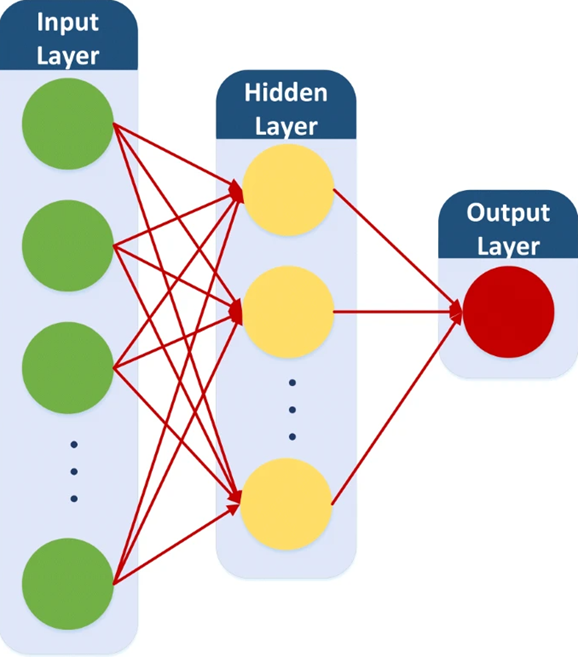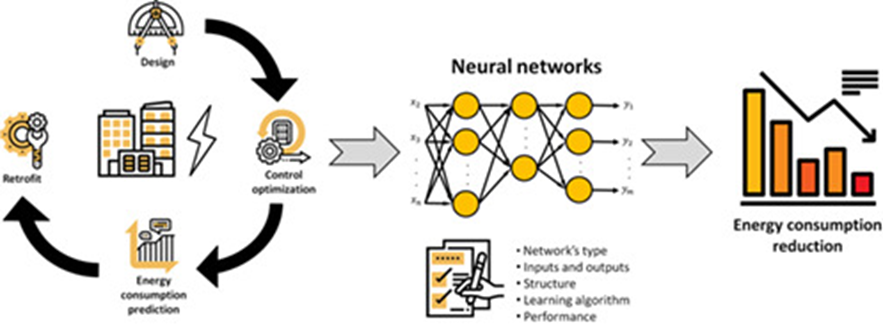REGISTRO DOI: 10.69849/revistaft/ar10201801011045
Leonardo da Silva
Abstract
Optimizing energy consumption in commercial buildings is becoming increasingly essential due to escalating energy costs and the demand for sustainable practices. Artificial Neural Networks (ANNs) have emerged as a powerful tool to address these challenges by offering real-time, intelligent solutions that adapt to usage patterns and environmental conditions. Inspired by the human brain, ANNs consist of layers of artificial neurons connected through weighted links. They are trained using historical and real-time data to recognize complex consumption patterns, predict future energy needs, and efficiently adjust systems like lighting, heating, ventilation, and air conditioning (HVAC). One of the primary advantages of ANNs is their ability to provide highly accurate energy demand forecasts. By analyzing extensive datasets—such as building usage, weather conditions, and occupancy levels—ANNs offer more precise predictions compared to traditional methods. This allows for proactive adjustments to HVAC systems, thereby enhancing energy efficiency and minimizing waste. ANNs also excel in adaptability, continuously learning and adjusting to new information and changing conditions, which is particularly valuable in environments with fluctuating usage and occupancy. Furthermore, integrating ANNs with Building Management Systems (BMS) adds a layer of intelligence and automation, optimizing energy consumption in real-time while considering parameters like occupancy levels and variable energy costs. This leads to substantial reductions in operational costs and energy waste. ANNs also simplify traditional control systems and enhance occupant comfort by maintaining optimal environmental conditions. However, challenges such as the need for high-quality training data, complex integration with existing systems, and data security concerns must be addressed. Despite these challenges, ANNs demonstrate significant potential for improving energy management in commercial buildings, with promising results from various studies indicating their effectiveness in reducing energy consumption and operational costs.
Keywords: Artificial Neural Networks (ANNs); Energy Optimization; Building Management Systems (BMS); Predictive Analytics; Energy Efficiency.
Optimizing energy consumption in commercial buildings has become increasingly crucial due to rising energy costs and the push for more sustainable practices. Artificial neural networks (ANNs) have emerged as a promising technology to address these challenges, offering intelligent solutions that adapt to usage patterns and environmental conditions in real time.
ANNs are computational models inspired by the human brain, consisting of layers of artificial neurons connected through weighted links. They are trained on historical and real-time data to recognize complex consumption patterns, aiming to predict future energy needs and adjust systems like lighting, heating, ventilation, and air conditioning (HVAC) efficiently. One of the key advantages of ANNs in energy optimization is their ability to provide highly accurate forecasts of energy demand. By analyzing large datasets—such as building usage patterns, weather conditions, and occupancy levels—ANNs enable more precise predictions compared to traditional methods. This precise forecasting capability allows for proactive adjustments to HVAC systems, significantly improving energy efficiency and reducing waste.

Source: Seyedzadeh et al. (2018).
Unlike traditional systems that operate on fixed rules, ANNs adapt continuously to new information and changing conditions. This adaptability is especially valuable in commercial buildings where usage and occupancy can vary widely throughout the day, week, or season. The integration of ANNs into Building Management Systems (BMS) adds an extra layer of intelligence and automation. This integration enables real-time optimization of energy consumption by considering parameters such as occupancy levels, weather forecasts, and variable energy costs. As a result, energy efficiency is maximized, leading to significant reductions in operational costs and energy waste.
Additionally, ANNs help reduce the complexity and cost of traditional control and simulation systems. They enhance occupant comfort by maintaining optimal environmental conditions tailored to user preferences, creating a more comfortable and productive environment. The ability of ANNs to analyze and process large volumes of data rapidly—including energy usage patterns, weather conditions, and occupancy levels—allows for informed decision-making based on detailed insights, contributing to more effective energy management.
However, the implementation of ANNs for energy optimization presents several challenges. The effectiveness of these networks depends on the availability of high-quality data for training. Moreover, integrating ANNs with existing control systems can be complex and may require significant initial investments. Data security and privacy concerns are also critical, especially in commercial environments that handle sensitive information.

Source: Wiley (2018).
Several studies highlight the potential of ANNs in energy optimization. Rahman, Srikumar, and Smith (2018) present a recurrent neural network (RNN) model designed for predicting electricity consumption profiles in commercial and residential buildings. Their approach, which uses hourly resolution data, shows that RNNs generally outperform traditional models in forecasting load profiles, though their effectiveness can vary by building type.
Similarly, Reynolds et al. (2018) investigate the development of smarter building controllers using zone-level ANNs. By integrating data on weather, occupancy, and indoor temperature, their approach achieved about a 25% reduction in energy consumption compared to baseline strategies. Additionally, when a time-of-use tariff was introduced, the optimization shifted energy use to cheaper periods, resulting in a 27% reduction in costs.
Kumar, Aggarwal, and Sharma (2013) explore the use of ANNs to predict energy consumption more reliably than traditional simulation models and regression techniques. Their findings reinforce ANNs as a promising design tool in building services engineering.
Ascione et al. (2017) propose a multi-stage framework called CASA, which combines multi-objective optimization and ANNs for cost-optimal energy retrofit analysis. The framework reduces computational efforts and times significantly, making it feasible for broader adoption in retrofit design. A case study of office buildings in southern Italy showed notable cost savings and reductions in energy consumption and emissions.
Kalogirou (2000) reviews various applications of ANNs in energy-related problems, such as modeling solar energy systems, estimating heating loads, and predicting energy consumption in passive solar buildings. The successful application of ANNs across these diverse areas suggests their broad potential for modeling in energy production and use.
In conclusion, artificial neural networks (ANNs) represent a transformative technology in optimizing energy consumption in commercial buildings. Their ability to process complex datasets and adapt in real time enables precise energy forecasting and dynamic system adjustments, leading to improved energy efficiency and cost savings. Despite challenges such as the need for high-quality data and integration complexities, the benefits of ANNs are substantial. As technology continues to advance, the integration of ANNs with Building Management Systems and other smart technologies is likely to enhance their capabilities further, driving greater adoption and contributing to more sustainable energy practices in the future.
References
Ascione, F., Bianco, N., Stasio, C., Mauro, G., & Vanoli, G. (2017). Artificial neural networks to predict energy performance and retrofit scenarios for any member of a building category: A novel approach. Energy, 118, 999-1017. https://doi.org/10.1016/J.ENERGY.2016.10.126.
Ascione, F., Bianco, N., Stasio, C., Mauro, G., & Vanoli, G. (2017). CASA, cost-optimal analysis by multi-objective optimisation and artificial neural networks: A new framework for the robust assessment of cost-optimal energy retrofit, feasible for any building. Energy and Buildings, 146, 200-219. https://doi.org/10.1016/J.ENBUILD.2017.04.069.
Kalogirou, S. (2000). Applications of artificial neural-networks for energy systems. Applied Energy, 67, 17-35. https://doi.org/10.1016/S0306-2619(00)00005-2.
Kumar, R., Aggarwal, R., & Sharma, J. (2013). Energy analysis of a building using artificial neural network: A review. Energy and Buildings, 65, 352-358. https://doi.org/10.1016/J.ENBUILD.2013.06.007.
Rahman, A., Srikumar, V., & Smith, A. (2018). Predicting electricity consumption for commercial and residential buildings using deep recurrent neural networks. Applied Energy, 212, 372-385. https://doi.org/10.1016/J.APENERGY.2017.12.051.
Reynolds, J., Rezgui, Y., Kwan, A., & Piriou, S. (2018). A zone-level, building energy optimisation combining an artificial neural network, a genetic algorithm, and model predictive control. Energy, 151, 729-739. https://doi.org/10.1016/J.ENERGY.2018.03.113.
Seyedzadeh, S., Rahimian, F. P., Glesk, I., & Roper, M. (2018). Machine learning for estimation of building energy consumption and performance: a review. Visualization in Engineering, 6, 1-20.

